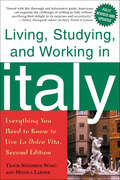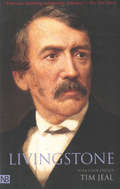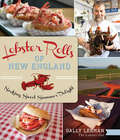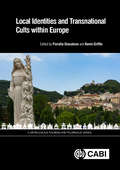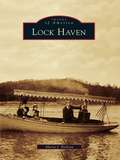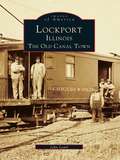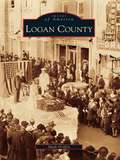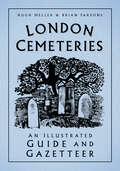- Table View
- List View
Living, Studying, and Working in Italy: Everything You Need to Know to Live La Dolce Vita
by Travis Neighbor Ward Monica LarnerAll the information you could possibly need for your time in Italy, whether a week or a decade, in a completely updated and revised editionSo, you want to move to Italy for six months but you don't speak the language well. How do you look for a job? Your heart is set on buying a farmhouse in Tuscany. What are the legal pitfalls to avoid? You'd like to study in Rome, but your college doesn't have a program. Which schools should you apply to?With all-new information on the Internet and on the effect of the conversion to the euro, this essential companion guide to Italy features- hundreds of addresses and Internet sites, from real estate agencies to job banks- details on visas, banking, taxes, and residency permits- freelance, seasonal, part-time, and full-time employment options- more than two hundred language schools, American colleges, and Italian universitiesWritten by Travis Neighbor Ward and Monica Larner, two seasoned expatriates, Living, Studying, and Working in Italy is packed with candid insider's tips and practical, up-to-date information for travelers of any age.
Livingston County
by Faye Tramble TeitloffOn December 13, 1798, the Kentucky General Assembly enacted legislation authorizing the formation of Livingston County, named for Robert R. Livingston of New York, who helped draft the Declaration of Independence. The year 1811 brought the invention of the steamboat, which created transportation and passenger trade up and down the Cumberland and Ohio Rivers. Solidifying Livingston County's importance as a river port and stop-off for travelers, steamboats also brought their share of interesting characters to town. The stories and pictures still remain today, as tales of the Ford's Ferry Gang, the Horrible Harpes, and the murder of a local slave--killed by a relative of Thomas Jefferson--are just a few of the fascinating accounts included in this book.
Livingstone's London
by Ken LivingstoneAs a passionate Londoner, Ken Livingstone has seen London change dramatically over the last 60 years. From playing on bomb sites in an era where St Pauls was the tallest building in the city, to 2019 where the gleaming towers of the Shard and Walkie Talkie dominate the skyline, thanks to new building rules introduced by his administration.With a witty and worldly eye he takes a look at his home town; the people, places and the politics that have shaped the landscape.On this personal journey he shares his views on every aspect of the city from his favourite restaurants and most loved buildings to anecdotes on fellow politicians and the triumphs, and disasters,
Livingstone: Revised and Expanded Edition
by Tim Jeal&“A superb biography, not to be missed either by armchair explorers or students of human nature…reveals the famed missionary and explorer as he really was.&”—Cleveland Plain DealerDavid Livingstone is revered as one of history&’s greatest explorers and missionaries, the first European to cross Africa, and the first to find Victoria Falls and the source of the Congo River. In this exciting new edition of his biography, Tim Jeal, author of the National Book Critics Circle Award-winning Stanley, draws on fresh sources and archival discoveries to provide the most fully rounded portrait of this complicated man—dogged by failure throughout his life despite his full share of success.Using Livingstone&’s original field notebooks, Jeal finds that the explorer&’s problems with his African followers were far graver than previously understood. From recently discovered letters he elaborates on the explorer&’s decision to send his wife, Mary, back home to England. He also uncovers fascinating information about Livingstone&’s importance to the British Empire and about his relationship with the journalist-adventurer Henry Morton Stanley. In addition, Jeal here evokes the full pathos of the explorer&’s final journey. This masterful, updated biography also features an excellent selection of new maps and illustrations.&“Fascinating.&”—Los Angeles Times&“A thrilling and in the end moving work…The Livingstone who emerges is a man of terrifying dimensions.&”—Irish Press
Livonia (Images of America)
by David MacgregorAt the turn of the 20th century, the township of Livonia was largely a rural community populated with farms, dirt roads, and a number of cheese factories. A few decades later, as the auto industry boomed in Detroit, white-collar workerssought places to raise their families outside of the city, and neighborhoods in Livonia went up seemingly overnight. The result was the creation of a quintessential American suburban city, one in which urban and rural lifestyles converged and formed a new kind of community. This bookcelebrates Livonia's development from the 19th to the 21st century, as it evolved from wilderness into a city that is routinely rated as one of the best places to raise a family in the United States.
Llama Llama Family Vacation (Llama Llama)
by Anna DewdneyTime to hop on a plane and go on vacation in this 8x8 based on an episode of the animated Llama Llama Netflix series.Look out, world--Llama Llama is a TV star! The beloved character, made famous by Anna Dewdney's best-selling picture books, is the star of his own original series, now airing on Netflix. In this episode-based 8x8, Llama Llama is preparing to go on his first vacation and plane ride with Mama Llama and Gram to Sandy Island! Your little llamas will love relating to their favorite picture book character as he faces new and challenging situations.
Lo que necesitas saber antes de viajar a Australia
by Calvin HornetDisfrutemos un poco del atractivo del país. Más de 20,000 millas de costa virgen, una serie de ciudades basadas en el ingenio y la intriga, la fauna endémica saltando por todas partes ... Aquí es donde se encuentra el monolito más grande del mundo, es el arrecife más largo, la selva más antigua, la cultura y una definición completamente nueva de desierto deshabitado. Con Australia, nunca hay un debate sobre si quieres ir. Es difícil encontrar un alma en el planeta que no esté inspirada por el pensamiento de esta inmensa nación isleña. La pregunta es más sobre cómo transformar Australia de la fantasía a la realidad. Primero son los aspectos prácticos. Simplemente volar por el país lleva cinco horas, nada más que paisaje chamuscado debajo de las puntas de las alas. Incluso en la siempre popular costa este, puede conducir durante horas sin ver nada más que las plantaciones de azúcar y el extraño canguro. El segundo es el costo. La transformación de Australia de una zona rural accidentada a una nación sofisticada no conoce fronteras, y el aumento de los costos tienen muchos visitantes que sobreviven con el vino en caja y los sándwiches de mermelada.
Lobster Rolls of New England: Seeking Sweet Summer Delight (American Palate)
by Sally LermanA lobster roll aficionado reviews forty lobster rolls from restaurants around New England.The mighty lobster roll is best enjoyed at a picnic table under a red umbrella accompanied by the sounds and smells of the sea. The perfect roll is all in the execution, and the variations are subtle but nearly endless—from top-sliced to buttered or mayonnaise-based. Blogger extraordinaire Sally Lerman chronicles her quest for the perfect bite in Lobster Rolls of New England. Savor mouthwatering descriptions of forty coastal lobster rolls, their storied venues, luscious photos and recipes for some of the lobster roll’s best complements. Discover the surprising history of the first trademarked lobster roll. Devour the very best New England has to offer, from Downeast Maine’s Trenton Bridge Lobster Pound to Captain Scott’s Lobster Dock in New London, Connecticut.
Lobster Shacks: A Road Guide to New England's Best Lobster Joints
by Mike UrbanA fun, road-trip-style guide to the 75 or so best shacks in New England, starting in Connecticut and heading north and east through Rhode Island, Massachusetts, New Hampshire, and Maine. Lobster Shacks is a fun, road-trip-style guide to the 75 or so best shacks in New England, starting in Connecticut and heading north and east through Rhode Island, Massachusetts, New Hampshire, and Maine. Each shack entry features a lively description which includes historical background, biographical portraits of the owners past and present, highlights from the menu, and driving directions. Scattered throughout the guide you will find feature recipes, lobster shack legends and lore, and information on local fishing fleets. Author Mike Urban is a veteran shack aficionado with years of experience searching for the best shacks. In short, whatever fits the clam shack zeitgeist and spirit will find its way into this unique guide.
Lobster Shacks: A Road-Trip Guide to New England's Best Lobster Joints (2nd Edition)
by Mike UrbanThe newly updated tour of New England's best roadside seafood Lobster Shacks is a fun, road-trip-style guide to the 75 or so best shacks in New England, starting in Connecticut and heading north and east through Rhode Island, Massachusetts, New Hampshire, and Maine. Each shack entry features a lively description which includes historical background, biographical portraits of the owners past and present, highlights from the menu, and driving directions. Scattered throughout the guide you will find feature recipes, lobster shack legends and lore, and information on local fishing fleets. Author Mike Urban is a veteran shack aficionado with years of experience searching for the best shacks and he hit the road again in 2015 to update this new edition. In short, whatever fits the lobster shack zeitgeist and spirit will find its way into this unique guide.
Local Identities and Transnational Cults within Europe (CABI Religious Tourism and Pilgrimage Series)
by Kevin Griffin Professor Fiorella Giacalone Alfonsina Bellio Riccardo Cruzzolin Paola De Salvo Laurent S. Fournier Etienne Guillaume André Julliard Tony Kiely Inga B. Kuzma Mathilde Lamothe Gaëlla Loiseau Daniele Parbuono Gianfranco SpitilliLocal-level pilgrimages, when based on strong expressions of faith, can have a much wider local, regional and international appeal. It has been estimated that pilgrims and religious tourists number around 330 million per year, meaning development of these faith identities can help drive destination visitation and regional development. This book explores the central role of ordinary people in the popularisation of faith-based practices, thus illustrating religious tourism as an expression of cultural identity. Focusing on the interrelationship of cultural groups and the overall formation of culture and society, this book: - Uses a range of multidisciplinary, sociological and ethnographic studies to illustrate the evolution of pilgrimage sites and saints. - Includes practical case studies and illustrations of religious tourism and pilgrimage development from a variety of international perspectives. - Provides a selection of discussion questions for each chapter, encouraging readers to engage with further study and investigation of these important issues. An invaluable review of cultural identity and faith, this book delivers to scholars, students and local policy makers a collection of current perspectives on the growth, development and evolution of faith practices surrounding contemporary and historical sites and saints.
Local Identities and Transnational Cults within Europe (CABI Religious Tourism and Pilgrimage Series)
by Kevin Griffin Professor Fiorella Giacalone Alfonsina Bellio Riccardo Cruzzolin Paola De Salvo Laurent S. Fournier Etienne Guillaume André Julliard Tony Kiely Inga B. Kuzma Mathilde Lamothe Gaëlla Loiseau Daniele Parbuono Gianfranco SpitilliLocal-level pilgrimages, when based on strong expressions of faith, can have a much wider local, regional and international appeal. It has been estimated that pilgrims and religious tourists number around 330 million per year, meaning development of these faith identities can help drive destination visitation and regional development. This book explores the central role of ordinary people in the popularisation of faith-based practices, thus illustrating religious tourism as an expression of cultural identity. Focusing on the interrelationship of cultural groups and the overall formation of culture and society, this book: - Uses a range of multidisciplinary, sociological and ethnographic studies to illustrate the evolution of pilgrimage sites and saints. - Includes practical case studies and illustrations of religious tourism and pilgrimage development from a variety of international perspectives. - Provides a selection of discussion questions for each chapter, encouraging readers to engage with further study and investigation of these important issues. An invaluable review of cultural identity and faith, this book delivers to scholars, students and local policy makers a collection of current perspectives on the growth, development and evolution of faith practices surrounding contemporary and historical sites and saints.
Local Wonders: Seasons in the Bohemian Alps
by Ted KooserFrom the book: Ted Kooser describes with exquisite detail and humor the place he calls home in the rolling hills of southeastern Nebraska known as the Bohemian Alps. Nothing is too big or too small for his attention. Memories of his grandmother's cooking are juxtaposed with reflections about the oldfashioned outhouse on his property. In the end, what makes life meaningful for Kooser are the ways in which his neighbors care for one another and how an afternoon walking with an old dog, or baking a pie, or decorating the house for Christmas can summon memories of his Iowa childhood. This writer is a seer in the truest sense of the word, discovering the extraordinary within the ordinary, the deep beneath the shallow, the abiding wisdom in the pithy Bohemian proverbs that are woven into his essays.
Locally Brewed
by Anna BlessingLocally Brewed celebrates the Midwest's craft brewing movement with profiles of 20 of the area's brewmasters and their breweries. These are entertaining and inspiring stories of the individuals who have been essential in the exponential growth of this movement, as told through vivid interviews, beautiful photography, and dynamic artwork.In just the past 20 years, beer has been transformed from a "low-class" drink to a pluralistic, populist drink with the same stylistic diversity and caring craftsmanship as wine. One of the strongest hotbeds of this cultural shift is in the Midwest, where independently owned craft brewers focus on the creative, artisanal elements of the beer-making process. Locally Brewed explores these trends and the fun, fascinating, and unique details of each brewery, including label art, hand-pull designs, and of course the brews themselves.This is a book that can be enjoyed by the "beer geek" and the casual imbiber alike, as it emphasizes the people behind the beer as well as the beers they brew. Special sidebars and pullouts show what makes each brewery special, weaving together the story of the indie beer movement, relevant to both small-town Midwesterners and big-city beer lovers.
Lock Haven (Images of America)
by Maria J. BoileauSituated between the Susquehanna River and Bald Eagle Creek, Lock Haven was developed by brothers Jerry and Willard Church in 1833 on 200 acres of farmland. The completion of the canal in 1834 stimulated the lumber industry, which became a source of prosperity for many years. Most of the large, beautiful homes located in Lock Haven's Water Street Historic District were built by families who prospered from over 50 years of timber harvest. When the lumber industry declined, other industries, including furniture, paper, fire bricks, and silk, provided new economic opportunities. The city was home to Piper Aviation and has seen the growth of Lock Haven University. Through floods and economic turmoil, Lock Haven's residents have continuously shown their strength of character. Lock Haven serves as a tribute to the beauty of the river, the mountains, and the people of this community.
Locked in Ice: Nansen's Daring Quest for the North Pole
by Peter LourieA spellbinding biography of Fridtjof Nansen, the pioneer of polar exploration, with a spotlight on his harrowing three-year journey to the top of the world.An explorer who many adventurers argue ranks alongside polar celebrity Ernest Shackleton, Fridtjof Nansen contributed tremendous amounts of new information to our knowledge about the Polar Arctic. At a time when the North Pole was still undiscovered territory, he attempted the journey in a way that most experts thought was mad: Nansen purposefully locked his ship in ice for two years in order to float northward along the currents. Richly illustrated with historic photographs, this riveting account of Nansen's Arctic expedition celebrates the legacy of an extraordinary adventurer who pushed the boundaries of human exploration to further science into the twentieth century.Christy Ottaviano Books
Lockport
by Paulette PecaLockport documents the creation and growth of a fascinating city that has played a vital role in American history. Here, the Erie Canal climbed the Niagara Falls escarpment and opened up the Great Lakes to East Coast commerce, a revolutionary achievement that brought unlimited hydroelectric power to western New York, fueling the early industrialization of Lockport. The city was at the forefront of technological and social innovation: the nation's first commercial telegraph line was laid here; the fire hydrant, the district central heating system, and the honeycomb automobile radiator were invented here; the first New York public school system was developed here; the first automatic voting machines were used here; and the National American Music Festival was created here. Lockport salutes the heroes and characters of Lockport's past and highlights the contribution of unsung generations of migrants-Irish, German, Polish and Italian-who built the Lock City's industries, homes, and reputation. It echoes the hum of thriving Main Street stores, bustling Market Street businesses, grand Locust Street homes, and flourishing fruit belt farms. Most of all, it rings with the ceaseless opening and closing of the famous locks that gave the city its name.
Lockport, Illinois: The Old Canal Town (Images of America)
by John LambThis new addition to the Images of America seriestraces the history of Lockport, Illinois, from theheight of its canal activity in the late 1860s to itsdecline as the lifeblood of the town in the early20th century. Lockport's story is revealed here inover 200 vintage photographs that trace the town'sprogress from its early days through the 1970s, whenthe canal reappeared as a recreational and tourist attraction. In Lockport, Illinois: The Old Canal Town, author John Lamb offers a rare glimpse into the lives of Lockport's founding fathers, as well as an in-depth look at the Demings family, whose fortunes and livelihoods depict the economic and cultural trends followed by many of Lockport's families. Lamb narrates this collection with an insightful text, providing many little-known facts about the town, the people, and the events that have shaped the history of this fascinating canal town.
Lockport: Historic Jewel of the Erie Canal
by Kathleen L. RileyFrom its beginnings in the early 19th century at the site where "art triumphed over nature," when the Erie Canal's Flight of Five locks was one of the wonders of the world, Lockport burst almost overnight into a thriving community that eventually outgrew the canal that gave it life. After many years of challenge and change, the city now looks to its glorious past to ensure its future.
Logan County
by Mark GriffinAs one of Kentucky's oldest counties, Logan County has a colorful history. Residents found religion at the Red River Meeting House during the Second Great Awakening. However, the land once known as Rogue's Harbor has been wrought with lawlessness. Visitors to the county today can tour the bank in the county seat of Russellville where the infamous Jesse James started his robbing spree in 1868. Tourists and residents alike are regaled with stories of a dueling Andrew Jackson and countless corrupt elections. Four men went on to become governors, while a fifth attempt fell short despite an infamous campaign. All of these things are documented in Images of America: Logan County along with the less controversial events in history: the everyday farmers who raised their cash crop of tobacco to contribute to a growing community and the establishment of the most southwestern of the Shaker communities at South Union.
Logic Pro X 10. 4 - Apple Pro Training Series: Professional Music Production (Apple Pro Training)
by David NahmaniRecord, arrange, mix, produce, and polish your audio files with this best-selling, Apple-certified guide to Logic Pro X 10.4. Veteran producer and composer David Nahmani uses step-bystep, project-based instructions and straightforward explanations to teach everything from basic music creation to sophisticated production techniques. Using the book’s downloadable lesson files and Logic Pro X, you’ll begin making music in the first lesson. From there, learn to record audio and MIDI data, create and edit sequences, and master mixing and automation techniques such as submixing with track stacks. Create both acoustic and electronic virtual drum performances using Drummer tracks with Drum Kit Designer and Drum Machine Designer. Use Logic Pro X MIDI FX and Smart Controls to control software synthesizers from a MIDI controller or an iPad. Harness the power of Smart Tempo to make sure all recordings, imported audio files, and samples play in time. Flex Time allows you to precisely edit the timing of notes inside an audio recording, and you’ll explore Flex Pitch to correct the pitch of a vocal recording. Finally, you mix, automate, and master the song, using plug-ins to process only selected sections or entire tracks, giving your audio creations the final polish needed to achieve a professional sound. Downloadable lesson and media files allow you to perform the hands-on exercises. Focused lessons take you step by step through practical, real-world tasks. Accessible writing style puts an expert instructor at your side Ample illustrations help you master techniques fast. Lesson goals and time estimates help you plan your time. Chapter review questions summarize what you’ve learned and help you prepare for the Apple certification exam.
Lola Levine and the Vacation Dream (Lola Levine #5)
by Monica BrownThe Levines are jetting off on a family vacation to Peru in the fifth book in this heartwarming chapter book series by acclaimed author Monica Brown.Lola is named after her tía Lola, who lives in Lima, Peru. Lola misses her aunt and dreams of visiting her. After Lola's dad has a successful art show, Lola's dream comes true. The Levines are going to Peru! Thousands of miles from home, Lola and Ben discover all the new adventures Lima has to offer. But will Lola and Ben manage to stay out of trouble?With Lola's and Ben's wit and talent for mischief, we can expect some international trouble in this adorable chapter book.
London By Tube: Over 80 intriguing short walks minutes away from London's tube stops
by Christopher WinnDid you know that..From Stonebridge Park on the Bakerloo Line you can walk to the largest Hindu temple in Europe?From Ealing Broadway on the Central Line you can walk to the oldest film studios in the world?From Stratford on the Central Line you can walk to, and abseil down, Britain's tallest sculpture?London is a city of surprises and variety, over 600 square miles packed full of character. And to really know London you must look beyond the obvious; there are broad vistas and quiet corners, iconic sights and grand boulevards, quaint villages, verdant parks, cobbled alleyways, museums, monuments, markets, theatres, and ancient churches.This book unearths and explores a stupendous range of interesting places, some well known, some less well known, some almost unknown, all of within an easy walk of a Tube station. If you want a day out and you want to do something different then London is your town, the Tube is your means and London by Tube is your guide.
London Cemeteries: An Illustrated Guide and Gazetteer
by Brian Parsons Hugh MellerLondon Cemeteries is a comprehensive guide to all cemeteries within Greater London. Listed alphabetically and with a map to help locate them, each entry includes the address, the date of foundation, the owner, the size, a note on its history, development and current state, and the names, dates and major achievements of any noteworthy people buried there. There are also chapters on the origins of London’s cemeteries and cemetery history, planning, architecture and epitaphs.Illustrated throughout with both modern photographs and a wide range of rarely seen archive images, it is an essential source of information for anyone interested in London’s social and architectural history. Alongside a refreshed design, this sixth edition has been extensively revised with updated biographies, additional details about buildings and visitor facilities, fresh research on flora and fauna and entries for 28 further cemeteries in the Greater London area.
London Eh to Zed: 101 Discoveries for Canadian Visitors to London
by Christopher WaltersDiscover London — and Canada — in one guidebook! Thousands of Canadians visit London, England, every year. But what their popular guidebooks always fail to mention are the over one hundred objects, monuments, and locations in the city associated with their own home and native land. Take for example the statue of half-mad General Charles Gordon standing beside the River Thames. His capture by rebels set in motion a dramatic rescue attempt that became Canada's first overseas military mission. Then there's the world's most famous suffragette Emmeline Pankhurst. Do Canadians know she marched on syphilis in Canada after winning the vote for women in Britain? Or that a cross-eyed doctor from McGill University in Montreal became London's most notorious serial killer after Jack the Ripper? London Eh to Zed is a light-hearted and entertaining walking guide especially for Canadians. Exploring seven neighbourhoods in London, it uncovers 101 fun discoveries about our history, character, passions, and foibles. Along streets in St. James's, Greenwich, and elsewhere, readers will meet men and women like the doomed adventurer Sir John Franklin, the un-amused Queen Victoria, and the tennis-loving but luckless Prince Rupert, first governor of the Hudson's Bay Company, who never collected any HBC Rewards.
